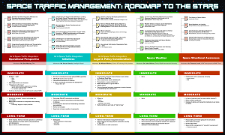Presentation Type
Paper (supporting PowerPoints may be added as Additional Files)
Location
Henderson Welcome Center
Start Date
16-1-2018 11:00 AM
End Date
16-1-2018 12:30 PM
Abstract
UTM, ATM, STM… slices of the sky?
This paper will examine the functional differences between Unmanned Aircraft Traffic Management Systems, Air Traffic Management Systems, and Space Traffic Management. Understanding both the similarities between the systems and the different functional requirements of each concept is critical in the discussion and development of STM. While there are many commonalities in each area, it is important to understand how the different environments affect the ability to develop policies, procedure and technologies to manage the vehicles operating in the distinct environment. Both technical and legal frameworks will be discussed.
Building a conceptual framework for STM can benefit from an understanding of the development of existing ATM and identifying where a similar evolutionary strategy can be applied. Considering questions like:
How much STM is necessary and when?
Who can provide the service?
How can it be funded? and
What international agreements are necessary?
Are foundational to the development of realistic policies to promote sustainability in space traffic management.
Area of Interest
Current Initiatives
Biographies
Included in
Aviation and Space Education Commons, International Law Commons, Law and Politics Commons, Management and Operations Commons, Multi-Vehicle Systems and Air Traffic Control Commons, Space Vehicles Commons, Transportation Law Commons

UTM, ATM, STM… slices of the sky?
Henderson Welcome Center
UTM, ATM, STM… slices of the sky?
This paper will examine the functional differences between Unmanned Aircraft Traffic Management Systems, Air Traffic Management Systems, and Space Traffic Management. Understanding both the similarities between the systems and the different functional requirements of each concept is critical in the discussion and development of STM. While there are many commonalities in each area, it is important to understand how the different environments affect the ability to develop policies, procedure and technologies to manage the vehicles operating in the distinct environment. Both technical and legal frameworks will be discussed.
Building a conceptual framework for STM can benefit from an understanding of the development of existing ATM and identifying where a similar evolutionary strategy can be applied. Considering questions like:
How much STM is necessary and when?
Who can provide the service?
How can it be funded? and
What international agreements are necessary?
Are foundational to the development of realistic policies to promote sustainability in space traffic management.


Comments
Full-text papers/presentations will be available post-conference
Visit the NAS Integration research panel